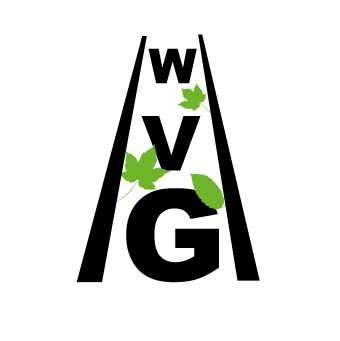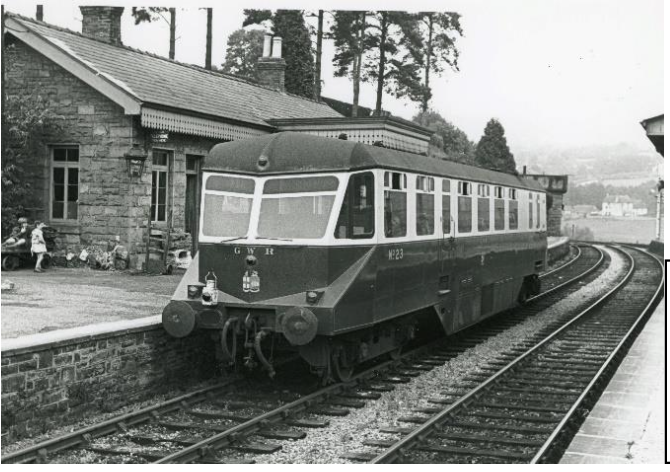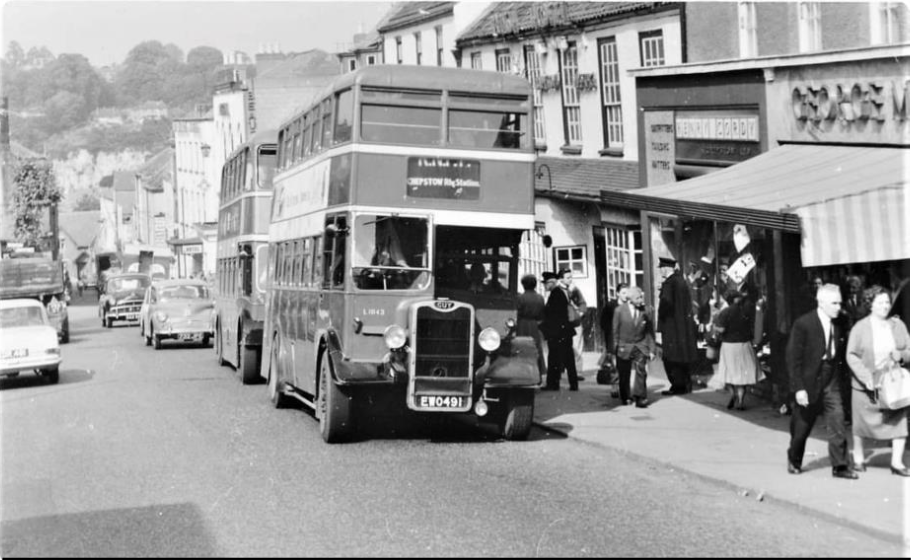Financial optimism, innovative publicity, and the eventual failure of the Wye Valley Railway.
The period before amalgamation with the GWR. 1876-1905.
Before the railway was built there was scepticism about its viability. On 7 February 1870 a letter to the Times, complained about the turnpike between Chepstow and Monmouth, commented:
‘There are people sanguine enough to entertain visionary plans of a railway along the valley but they may just as well amuse themselves with schemes of a balloon navigation to the moon.’
However, on 28 September 1874 extravagant claims in a Prospectus to attract investors was published in The Globe:
‘The railway will command a very large traffic from tourists... and also in goods.’
Tintern Abbey- the iconic tourist attraction in the Wye Valley - Richard E Trigg
Much was expected by the promoters as recorded in the Monmouthshire Beacon 21 October 1876:
‘Whilst opening up a new district hitherto unapproached by railway traffic, the new line will prove a great convenience not only to the locality through which it runs, but to the travelling public at large...’
‘The gradients and curves of the line are good, the line having been constructed with the idea of accommodating the through traffic from Bristol to the north of England....’
The promoters estimated that for the first years of operation revenue would amount to £37,000 per annum. This was wildly optimistic with gross receipts for the first ten years of operation averaging only £5.200 per annum and they lost money for every year between 1876-1904. The director’s reports put the losses down to various factors such as bad weather which had a detrimental effect on the highly valued tourist trade and the decline and eventual closure of many of the manufacturing industries of the lower Wye Valley. This led to lack of maintenance and poor services, dissuading the public to travel. The imposition by the Duke of Beaufort of demanding terms to build and operate the Wireworks branch, under which no tolls could were receivable despite the expense of constructing the branch, was another significant factor.
50 -55% of gross receipts had to be paid to the GWR who supplied locomotives and rolling stock and worked and maintained the line. This was not an unusual sum but residual revenue for the WVR was insufficient to cover loan charges and other debts.
Horse taxi on the way from Chepstow to Tintern.– courtesy of Ron Morris
Early competition came from horse taxis. The photo on the left is taken at Wyndcliff on the way from Chepstow to Tintern. Oakapple, the horse on the right is buried at St. Arvans where the taxi was based.
Excursion trains to popular destinations were frequently advertised as a way of raising revenue. This advertisement was displayed in the Wilts and Gloucestershire Standard on 28 June 1879.
Factors outside the control of the WVR contributed to the poor results e.g. A loss of £53.90 was made in 1881 caused by diversion of traffic from Bristol over Severn Railway Bridge (demolished in 1967) after the pier at Portskewitt had been burned.
The company affairs were mismanaged and there were irregularities with the company funds which in 1881 led to legal action against the Chairman, Mr. W. Hawes and other members of the board. A receiver was appointed by the shareholders and a new chairman and board of directors appointed.
The diversification into the purchase of wharves in Chepstow is an example of mismanagement. It was reported in the 1 Apr 1882 AGM that:
‘The company had been in a very peculiar position with regards to the Chepstow wharves. Every effort has been made to get them used as wharves but there was apparently no traffic. The steam- boat company that had been formed came to grief and the wharves were for the time lying useless. Simultaneously the executors of the people of whom the wharves had been bought pressed for payment due to them. At last, however, as was stated in the last report, a lease had been effected, the wharves being let to a large iron company for shipbuilding purposes.’
The closure of the Redbrook Tinplate Works in March 1883 which did not reopen until the following year affected receipts as the Works was the major industry site contributing to goods receipts. The works closed again in the winter of 1888-9 because of the McKinley tariffs in the USA. These tariffs raised the average tax on tinplate imports from 30% to nearly 70% in an attempt to stimulate the infant domestic tin-plate industry. Lower tariffs were introduced in 1894.
The directors assumed that the opening of the Severn Tunnel in 1886 would result in profits being made but this turned out to be a false hope.
Excursion trains were good business on Bank Holidays, but the income was not sufficient to stabilise the finances of the railway. This timetable from Whit Monday 10 June 1889 includes four excursions from Birmingham and one from Wolverhampton.
Courtesy of Brian Handley
The WVR company finally collapsed in 1889 and for a second time a receiver was appointed, this time to wind up the railway’s affairs and to handle the eventual amalgamation with the Great Western Railway.
The most popular excursion destination was, by far, Tintern Abbey and the highlight of an excursion was the sight of Tintern by moonlight. On Monday 29 May 1880, a bank holiday, over 2000 excursionists arrived by special train at Tintern.
1890 poster
c 1850 engraving of Tintern Abbey by moonlight
This amalgamation with the GWR finally took place in July 1905. The shareholder unanimously accepted an offer of £12.50 for each £100 preference stock and 50p for each £20 ordinary share thereby losing nearly all their investment. Each £100 WVR 5 % debenture stock was exchanged for an equal amount of GWR 4 1⁄2 % stock.
After amalgamation services improved and maintenance that had fallen behind was stepped up.
The GWR and British Railway years - passenger trains. 1905-1961
Between 1920 and 1930 the number of passengers on the railways of Britain fell by 44% and the WVR now under GWR ownership was not immune to that.
In 1926 the GWR did an extensive study of Branch lines which included recommendations for closure. The Wye Valley Railway was not recommended and so we can assume that the line made an adequate return at that time.
The GWR publicity department targeted the Wye Valley with booklets and posters in the 20’s and 30’s.
In 1923 ‘The Wye Valley’ booklet was issued as No.6 in the ‘Handy Aids’ Series which included the Cornish Riviera and Wonderful Essex. It is something of a period piece with quotes from Shakespeare, William Gilpin (considered by some as the originator of guidebooks), Wordsworth and Thackery. The style of the booklet can be judged from these extracts about Tintern and Monmouth:
‘We now approach the magnificent edifice which may fairly be described the as the great architectural treasure, not only of the Wye Valley.........There is nothing quite like it in all England ‘
‘It (Monmouth) lies embowered among gentle hills, diversified by wood, corn and pasture, and rises from the river with considerable stateliness in the form of an amphitheatre.’
Between 1927 and 1932 the GWR opened six unmanned halts in the hope to increase passenger traffic. A camping coach was stationed at Tintern from 1935. In the war years most of the camping coaches were requisitioned. The Tintern coach reappeared after the war and in 1961 a British Railways brochure lists a stay at Tintern for £12 a week during the high season from 10 June to 2 September. Calor gas was provided for cooking, heating and lighting.
1931 GWR poster - Science Museum CC 4.0
After the 1880 black and white poster advertising Tintern by moonlight (above) new technology became available for poster prints pioneered by Toulouse-Lautrec in France. High quality colour printed posters could be produced in quantity. 100 of the posters on the left were sent to USA to advertise first class rail travel in the United Kingdom. It is curious that Tintern is placed in England. The GWR produced a wide range of these travel posters which were a very popular form of advertising.
The graphic artist was Freda Lingstrom. The Norwegian and Swedish governments commissioned her to produce travel advertising material for the English market. She later changed career and became co-creator of Andy Pandy and The Flowerpot Men in the 1950s and then Director of Children’s Television in 1951.
In a further attempt to attract tourists in 1938 the GWR published the ‘Rambles in the Wye Valley’ includes 3 circular walks along the Wye Valley line. No 1 is a route from Chepstow to Tintern, Brockweir and Netherhope Halt with the option of buying a ticket to finish the ramble at any station and taking the train back to Chepstow.
Ramblers’ return specials were introduced by the GWR to promote its country network. Each weekday GWR circular tours were offered from Gloucester through ‘The Beautiful Wye Valley’, as well as, three circular tours from Newport. Passengers were entitled to break their journey as stations such as Monmouth, Redbrook-on-Wye, St. Briavels, Tintern and Chepstow. Cheap day fares were also offered.
As passenger numbers dwindled the GWR introduced the popular streamlined diesel railcars in 1941.
Diesel Railcar W23W at Tintern station
Great Western Trust
Red and White bus service in Chepstow 1962 – Colin Ruth
Motor car ownership was increasingly significantly in the 1930s and after the war but by far the greatest threat to WVR passenger traffic came from the Red and White buses. The Chepstow based Company was formed in 1921 and by 1928 was operating buses throughout South Wales. Expansion was rapid and by 1937 it ran a fleet of over 400 vehicles. The buses stopped in more convenient locations than the train. For example, Tintern station was more than a mile from the Abbey.
The Red and White services were far more frequent as can be seen from the 1958 Route 32 timetable (below) compared with the Wye Valley line in both 1958 and 1876.
In 1958 there were 11 buses a day on weekdays from Chepstow to Monmouth (journey time 50 minutes ) and 7 to Brockweir. On Sundays 5 buses ran to Monmouth and 4 to Brockweir. The last bus left Chepstow on a Saturday at 10.15 pm.
On the Wye Valley Line in the same year there were 5 trains a day to Monmouth (journey time 48 minutes). The last bus left Chepstow at 7.55 pm on a weekday. There was no Sunday service on the train. In 1876 the train took 52 minutes and there were four services on a weekday only.
The train service had improved little since the opening of the line and the bus service in 1958 was far superior to the train.
So, it cannot have been a surprise that on 30 August 1958 it was reported in the Western Mail:
‘Only one ticket sold during a day at Monmouth Railway Station recently – and that was a 6 1⁄2 d one.’
In the last year of operation the line lost £23,000. Passenger services finished on 4 January 1959, four years before the Beeching Report was published. Over 400 people travelled on the last train
When the line closed for passenger traffic in 1959 Tintern and Redbrook remained open for parcels and goods traffic until 1964.
The last passenger train at Tintern -courtesy of Sheila Black
The Stephenson Locomotive Society organised the eight coach train that ran the last as the last passenger train. The following account of the event is taken from the Stephenson Locomotive Society Journal.
Publication date of the Stephenson Locomotive Society journal was in February 1959
(courtesy of the Friend Railway Studies Association)
Competition and decline-freight
In the early years the only alternative for freight carriage for most railway lines was by horse and cart which would have been slow and expensive. At this point railways had a near monopoly for freight.
However, the WVR was also subject to competition from steamships. Much of the output from the wireworks used this method of transport. La Belle Marie a Forest of Dean market boat operated successfully from Brockweir between 1904 and 1911 carrying a wide range of general goods that would otherwise have been suitable for carriage by the WVR.
La Belle Marie Steam Yacht -Ian Pope collection
Sentinel steam lorry c1929. (CC 1.0 public domain Rob Mitchell)
Steam lorries entered into widespread use for commercial haulage in the early part of the 20th century. The Sentinal six-wheel vehicle of 1928 could carry loads up to 15 tons. By 1934 Sentinel lorries could run comfortably at 45 mph.
The Salter report in 1932 recognised that railways were at an unfair disadvantage to the road haulage industry which was unregulated. It concluded that the existing system of road funding represented a subsidy to road users. The government adopted the recommendations and introduced a licensing system for commercial heavy goods vehicles and their operators. The changes were supported by the railway companies, whose price restrictions were partly lifted. The maximum speed for road haulage vehicles was reduced to 20 mph for vehicles over 3 tons in weight.
The government changes were blamed for driving steam haulage off the road and in the 1930s internal combustion engines were replacing steam. In 1956 the maximum speed this increased to 30 mph and now stands at 60 mph on dual carriageways and motorways.
From the mid-1950s onwards road freight made significant inroads into the rail freight traffic business. One of the consequences was the closure of all goods and parcel traffic facilities on the WVR in 1964 as local deliveries were now dominated by the flexibility road of road transport.
The quarry traffic continued for nearly another 30 years as a result of powerful diesel engines hauling the wagons loaded with the limestone ballast.
Last dates for freight traffic were:
4 January 1964 - last goods traffic north of Tintern Quarry.
December 1981 - last train from Tintern Quarry though Tidenham tunnel.
September 1992 – last train to use the line departs from Dayhouse Quarry, Tidenham .


















